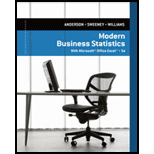
a.
Find the p-value and state the conclusion.
a.
Answer to Problem 36E
The p-value is 0.003.
The conclusion is “reject the null hypothesis”.
Explanation of Solution
Calculation:
The given information is that
The hypotheses are given below:
Null hypothesis:
Alternative hypothesis:
Test statistic:
The formula for finding test statistic is as follows:
Here,
Substitute
Thus, the value of the test statistic is −2.80.
Use Table 1: Cumulative probabilities for the standard normal distribution to find probability.
- Locate the value –2.8 in the first column.
- Locate the value 0.00 in the first row.
- The intersecting value that corresponds to–2.80 is 0.0026.
Thus, the p-value is 0.0026.
Rejection rule:
If
If
Conclusion:
Here, the p-value is less than the level of significance.
That is,
By the rejection rule, the null hypothesis is rejected.
b.
Find the p-value and state the conclusion.
b.
Answer to Problem 36E
The p-value is 0.1151.
The conclusion is “do not reject the null hypothesis”.
Explanation of Solution
Calculation:
The given information is that
Test statistic:
Substitute
Thus, the value of the test statistic is −1.20.
Use Table 1: Cumulative probabilities for the standard normal distribution to find probability.
- Locate the value –1.2 in the first column.
- Locate the value 0.00 in the first row.
- The intersecting value that corresponds to the –1.20 is 0.1151.
Thus, the p-value is 0.1151.
Conclusion:
Here, the p-value is greater than the level of significance.
That is,
By the rejection rule, the null hypothesis is not rejected.
c.
Find the p-value and state the conclusion.
c.
Answer to Problem 36E
The p-value is 0.0228.
The conclusion is “reject the null hypothesis”.
Explanation of Solution
Calculation:
The given information is that
Test statistic:
Substitute
Thus, the value of the test statistic is −2.00.
Use Table 1: Cumulative probabilities for the standard normal distribution to find probability.
- Locate the value –2.0 in the first column.
- Locate the value 0.00 in the first row.
- The intersecting value that corresponds to the –2.00 is 0.0228.
Thus, the p-value is 0.0228.
From the output, the test statistic is −2.00 and the p-value is 0.0228.
Conclusion:
Here, the p-value is less than the level of significance.
That is,
By the rejection rule, the null hypothesis is rejected.
d.
Find the p-value and state the conclusion.
d.
Answer to Problem 36E
The p-value is 0.7881.
The conclusion is “do not reject the null hypothesis”.
Explanation of Solution
Calculation:
The given information is that
Test statistic:
Substitute
Thus, the value of the test statistic is 0.80.
Use Table 1: Cumulative probabilities for the standard normal distribution to find probability.
- Locate the value 0.8 in the first column.
- Locate the value 0.00 in the first row.
- The intersecting value that corresponds to the 0.80 is 0.7881.
Thus, the p-value is 0.7881.
Conclusion:
Here, the p-value is greater than the level of significance.
That is,
By the rejection rule, the null hypothesis is not rejected.
Want to see more full solutions like this?
Chapter 9 Solutions
Modern Business Statistics with Microsoft Excel (MindTap Course List)
- solve the question based on hw 1, 1.41arrow_forwardT1.4: Let ẞ(G) be the minimum size of a vertex cover, a(G) be the maximum size of an independent set and m(G) = |E(G)|. (i) Prove that if G is triangle free (no induced K3) then m(G) ≤ a(G)B(G). Hints - The neighborhood of a vertex in a triangle free graph must be independent; all edges have at least one end in a vertex cover. (ii) Show that all graphs of order n ≥ 3 and size m> [n2/4] contain a triangle. Hints - you may need to use either elementary calculus or the arithmetic-geometric mean inequality.arrow_forwardWe consider the one-period model studied in class as an example. Namely, we assumethat the current stock price is S0 = 10. At time T, the stock has either moved up toSt = 12 (with probability p = 0.6) or down towards St = 8 (with probability 1−p = 0.4).We consider a call option on this stock with maturity T and strike price K = 10. Theinterest rate on the money market is zero.As in class, we assume that you, as a customer, are willing to buy the call option on100 shares of stock for $120. The investor, who sold you the option, can adopt one of thefollowing strategies: Strategy 1: (seen in class) Buy 50 shares of stock and borrow $380. Strategy 2: Buy 55 shares of stock and borrow $430. Strategy 3: Buy 60 shares of stock and borrow $480. Strategy 4: Buy 40 shares of stock and borrow $280.(a) For each of strategies 2-4, describe the value of the investor’s portfolio at time 0,and at time T for each possible movement of the stock.(b) For each of strategies 2-4, does the investor have…arrow_forward
- Negate the following compound statement using De Morgans's laws.arrow_forwardNegate the following compound statement using De Morgans's laws.arrow_forwardQuestion 6: Negate the following compound statements, using De Morgan's laws. A) If Alberta was under water entirely then there should be no fossil of mammals.arrow_forward
- Negate the following compound statement using De Morgans's laws.arrow_forwardCharacterize (with proof) all connected graphs that contain no even cycles in terms oftheir blocks.arrow_forwardLet G be a connected graph that does not have P4 or C3 as an induced subgraph (i.e.,G is P4, C3 free). Prove that G is a complete bipartite grapharrow_forward
 Glencoe Algebra 1, Student Edition, 9780079039897...AlgebraISBN:9780079039897Author:CarterPublisher:McGraw Hill
Glencoe Algebra 1, Student Edition, 9780079039897...AlgebraISBN:9780079039897Author:CarterPublisher:McGraw Hill Big Ideas Math A Bridge To Success Algebra 1: Stu...AlgebraISBN:9781680331141Author:HOUGHTON MIFFLIN HARCOURTPublisher:Houghton Mifflin Harcourt
Big Ideas Math A Bridge To Success Algebra 1: Stu...AlgebraISBN:9781680331141Author:HOUGHTON MIFFLIN HARCOURTPublisher:Houghton Mifflin Harcourt

